Evaluating the Performance of Satellite-Derived Soil Moisture Products Across South America Using Minimal Ground-Truth Assumptions in Spatiotemporal Statistical Analysis
Abstract
1. Introduction
2. Study Area and Datasets
2.1. Study Area
2.2. Microwave Passive and Active SMO Datasets
2.3. Reference SMO Datasets
2.4. Ancillary Datasets
3. Methods
3.1. Data Preprocessing
- SMAP SMO values were filtered for SMO < 0.02 m3/m3, SMO > 0.50 m3/m3, and when recommended retrieval flag. The daily average descending and ascending SMO was resampled to 25 km using the nearest-neighbor method [48].
- SMOS SMO values were filtered to eliminate unreliable SMO retrievals based on RFI probability > 0.2, Data Quality Index < 0.1, and SMO not within the range of 0–0.6 m3/m3 [26]. The daily average descending and ascending of SMOS SMO retrievals were calculated.
- ASCAT H113 SMO retrievals were masked using the information of Surface State Flag (SSF) for snow/frozen probability and retrieval error > 50%. SMO was resampled to 25 km using the nearest-neighbor resampling algorithm. SMO was transformed from the degree of saturation (%) to m3/m3 using soil porosity estimates from the database of world soil for the upper layer (0–40cm) [14,49] and available through the ESA website.
- GLDAS-Noah ERA5 SMO data were used when the temperature of the topsoil was above 0 °C [50].
3.2. Error Metrics
3.3. Triple Collocation Method
3.4. Hovmöller Diagrams
4. Results and Discussion
4.1. Assessment of Satellite SMO Products Against Reference Datasets
4.2. Triple Collocation Analysis
4.3. Spatiotemporal Variability and Interpretation
5. Conclusions
Author Contributions
Funding
Data Availability Statement
Conflicts of Interest
References
- Wang, Y.; Shi, L.; Hu, Y.; Hu, X.; Song, W.; Wang, L. A comprehensive study of deep learning for soil moisture prediction. Hydrol. Earth Syst. Sci. 2024, 28, 917–943. [Google Scholar] [CrossRef]
- Horton, D.; Johnson, J.T.; Al-Khaldi, M.; Baris, I.; Park, J.; Bindlish, R. Soil Moisture During 2015 Spring Flood Events from the SMAP Radar Time-Series Ratio Algorithm. In Proceedings of the 2024 United States National Committee of URSI National Radio Science Meeting, USNC-URSI NRSM 2024—Proceedings, Boulder, CO, USA, 9–12 January 2024; p. 352. [Google Scholar] [CrossRef]
- Rajani, P.K.; Deshpande, G.; Goswami, M.; Kolhe, J.; Khandagale, V.; Mujumdar, M.; Singh, B.B. IoT-Based Low-Cost Soil Moisture and Soil Temperature Monitoring System. Int. J. Electr. Electron. Eng. 2023, 10, 66–74. [Google Scholar] [CrossRef]
- Chaube, U.C.; Pandey, A.; Singh, V.P. Soil Moisture and Its Measurement. In Canal Irrigation Systems in India: Operation, Maintenance, and Management; Springer: Cham, Switzerland, 2023; pp. 471–483. [Google Scholar] [CrossRef]
- Liu, Y.Y.; Parinussa, R.M.; Dorigo, W.A.; De Jeu, R.A.M.M.; Wagner, W.; van Dijk, A.I.J.M.; McCabe, M.F.; Evans, J.P. Developing an improved soil moisture dataset by blending passive and active microwave satellite-based retrievals. Hydrol. Earth Syst. Sci. 2011, 15, 425–436. [Google Scholar] [CrossRef]
- Gao, Y.; Colliander, A.; Burgin, M.S.; Walker, J.P.; Chae, C.; Dinnat, E.; Cosh, M.H.; Caldwell, T.; Berg, A.; Martínez-Fernández, J. L-, C- and X-band passive microwave soil moisture retrieval algorithm parameterization using in situ validation sites. In Proceedings of the International Geoscience and Remote Sensing Symposium (IGARSS), Valencia, Spain, 22–27 July 2018; pp. 1434–1437. [Google Scholar] [CrossRef]
- Wagner, W.; Lindorfer, R.; Hahn, S.; Kim, H.; Vreugdenhil, M.; Gruber, A.; Fischer, M.; Trnka, M. Global Scale Mapping of Subsurface Scattering Signals Impacting ASCAT Soil Moisture Retrievals. IEEE Trans. Geosci. Remote Sens. 2024, 62, 1–20. [Google Scholar] [CrossRef]
- Mousa, B.G.; Shu, H.; Freeshah, M.; Tariq, A. A Novel Scheme for Merging Active and Passive Satellite Soil Moisture Retrievals Based on Maximizing the Signal to Noise Ratio. Remote Sens. 2020, 12, 3804. [Google Scholar] [CrossRef]
- Gibon, F.; Mialon, A.; Richaume, P.; Rodríguez-Fernández, N.; Aberer, D.; Boresch, A.; Crapolicchio, R.; Dorigo, W.; Gruber, A.; Himmelbauer, I.; et al. Estimating the uncertainties of satellite derived soil moisture at global scale. Sci. Remote Sens. 2024, 10, 100147. [Google Scholar] [CrossRef]
- Colliander, A.; Cosh, M.H.; Berg, A.; Misra, S.; Thomas, J.; Bourgeau-Chavez, L.; Kelly, V.; Kraatz, S.; Siqueira, P.; Roy, A.; et al. Development of SMAP Retrievals for Forested Regions: SMAPVEX19-22 and SMAPVEX22-Boreal. In Proceedings of the International Geoscience and Remote Sensing Symposium (IGARSS), Kuala Lumpur, Malaysia, 17–22 July 2022; pp. 4228–4231. [Google Scholar] [CrossRef]
- Wang, P.; Zeng, J.; Chen, K.-S.; Ma, H.; Bi, H.; Chen, Q.; Letu, H. Effects of Spatial Heterogeneity on Satellite Soil Moisture Products. In Proceedings of theIGARSS 2024—2024 IEEE International Geoscience and Remote Sensing Symposium, Athens, Greece, 7–12 July 2024; pp. 5032–5035. [Google Scholar] [CrossRef]
- Yang, W.; Guo, F.; Zhang, X.; Zhang, Z.; Zhu, Y. High temporal resolution quasi-global landscape soil freeze–thaw map from spaceborne GNSS-R technology and SMAP radiometer measurements. Int. J. Appl. Earth Obs. Geoinf. 2024, 128, 103777. [Google Scholar] [CrossRef]
- Kim, H.; Parinussa, R.; Konings, A.G.; Wagner, W.; Cosh, M.H.; Lakshmi, V.; Zohaib, M.; Choi, M. Global-scale assessment and combination of SMAP with ASCAT (active) and AMSR2 (passive) soil moisture products. Remote Sens. Environ. 2018, 204, 260–275. [Google Scholar] [CrossRef]
- Mousa, B.G.; Shu, H. Spatial Evaluation and Assimilation of SMAP, SMOS, and ASCAT Satellite Soil Moisture Products Over Africa Using Statistical Techniques. Earth Space Sci. 2020, 7, 1–16. [Google Scholar] [CrossRef]
- Brocca, L.; Melone, F.; Moramarco, T.; Wagner, W.; Hasenauer, S. ASCAT soil wetness index validation through in situ and modeled soil moisture data in central Italy. Remote Sens. Environ. 2010, 114, 2745–2755. [Google Scholar] [CrossRef]
- Gruber, A.; Dorigo, W.A.; Zwieback, S.; Xaver, A.; Wagner, W. Characterizing Coarse-Scale Representativeness of in situ Soil Moisture Measurements from the International Soil Moisture Network. Vadose Zone J. 2013, 12, 1–16. [Google Scholar] [CrossRef]
- Dorigo, W.; Himmelbauer, I.; Aberer, D.; Schremmer, L.; Petrakovic, I.; Zappa, L.; Preimesberger, W.; Xaver, A.; Annor, F.; Ardö, J.; et al. The International Soil Moisture Network: Serving Earth system science for over a decade. Hydrol. Earth Syst. Sci. Discuss. 2021, 25, 1–83. [Google Scholar] [CrossRef]
- Leroux, D.J.; Kerr, Y.H.; Al Bitar, A.; Bindlish, R.; Jackson, T.J.; Berthelot, B.; Portet, G.; Wagner, W.; Brocca, L.; Naeimi, V.; et al. Comparison Between SMOS, VUA, ASCAT, and ECMWF Soil Moisture Products Over Four Watersheds in U.S. IEEE Trans. Geosci. Remote Sens. 2014, 52, 1562–1571. [Google Scholar] [CrossRef]
- Albergel, C.; de Rosnay, P.; Gruhier, C.; Muñoz-Sabater, J.; Hasenauer, S.; Isaksen, L.; Kerr, Y.; Wagner, W. Evaluation of remotely sensed and modelled soil moisture products using global ground-based in situ observations. Remote Sens. Environ. 2012, 118, 215–226. [Google Scholar] [CrossRef]
- Su, C.-H.H.; Ryu, D.; Crow, W.T.; Western, A.W. Beyond triple collocation: Applications to soil moisture monitoring. J. Geophys. Res. 2014, 119, 6419–6439. [Google Scholar] [CrossRef]
- Gruber, A.; Su, C.-H.; Zwieback, S.; Crow, W.; Dorigo, W.; Wagner, W. Recent advances in (soil moisture) triple collocation analysis. Int. J. Appl. Earth Obs. Geoinf. 2016, 45, 200–211. [Google Scholar] [CrossRef]
- Persson, A. The Story of the Hovmöller Diagram: An (Almost) Eyewitness Account. Bull. Am. Meteorol. Soc. 2017, 98, 949–957. [Google Scholar] [CrossRef]
- De-Leon, Y.; Paldor, N. Commonly used methods fail to detect known propagation speeds of simulated signals from time-longitude (Hovmöller) diagrams. Ocean Sci. 2019, 15, 1593–1599. [Google Scholar] [CrossRef]
- Zaninelli, P.G.; Menéndez, C.G.; Falco, M.; López-Franca, N.; Carril, A.F. Future hydroclimatological changes in South America based on an ensemble of regional climate models. Clim. Dyn. 2019, 52, 819–830. [Google Scholar] [CrossRef]
- Rossato, L.; de Jeu, R.; dos Santos Alvalá, R.C.; Souza, S. Evaluation of soil moisture from satellite observations over South America. Int. J. Remote Sens. 2011, 32, 8013–8031. [Google Scholar] [CrossRef]
- Ma, H.; Zeng, J.; Chen, N.; Zhang, X.; Cosh, M.H.; Wang, W. Satellite surface soil moisture from SMAP, SMOS, AMSR2 and ESA CCI: A comprehensive assessment using global ground-based observations. Remote Sens. Environ. 2019, 231, 111215. [Google Scholar] [CrossRef]
- Cui, C.; Xu, J.; Zeng, J.; Chen, K.-S.S.; Bai, X.; Lu, H.; Chen, Q.; Zhao, T. Soil Moisture Mapping from Satellites: An Intercomparison of SMAP, SMOS, FY3B, AMSR2, and ESA CCI over Two Dense Network Regions at Different Spatial Scales. Remote Sens. 2018, 10, 33. [Google Scholar] [CrossRef]
- Zhang, X.; Zhang, T.; Zhou, P.; Shao, Y.; Gao, S.; Zhang, X.; Zhang, T.; Zhou, P.; Shao, Y.; Gao, S. Validation analysis of SMAP and AMSR2 soil moisture products over the United States using ground-based measurements. Remote Sens. 2017, 9, 104. [Google Scholar] [CrossRef]
- Baker, J.C.A.; De Souza, D.C.; Kubota, P.Y.; Buermann, W.; Coelho, C.A.S.; Andrews, M.B.; Gloor, M.; Garcia-Carreras, L.; Figueroa, S.N.; Spracklen, D.V. An Assessment of Land–Atmosphere Interactions over South America Using Satellites, Reanalysis, and Two Global Climate Models. J. Hydrometeorol. 2021, 22, 905–922. [Google Scholar] [CrossRef]
- Beck, H.E.; McVicar, T.R.; Vergopolan, N.; Berg, A.; Lutsko, N.J.; Dufour, A.; Zeng, Z.; Jiang, X.; van Dijk, A.I.J.M.; Miralles, D.G. High-resolution (1 km) Köppen-Geiger maps for 1901–2099 based on constrained CMIP6 projections. Sci. Data 2023, 10, 724. [Google Scholar] [CrossRef]
- Colliander, A.; Jackson, T.J.J.; Bindlish, R.; Chan, S.; Das, N.; Kim, S.B.B.; Cosh, M.H.H.; Dunbar, R.S.S.; Dang, L.; Pashaian, L.; et al. Validation of SMAP surface soil moisture products with core validation sites. Remote Sens. Environ. 2017, 191, 215–231. [Google Scholar] [CrossRef]
- Entekhabi, D.; Njoku, E.G.; O’Neill, P.E.; Kellogg, K.H.; Crow, W.T.; Edelstein, W.N.; Entin, J.K.; Goodman, S.D.; Jackson, T.J.; Johnson, J.; et al. The soil moisture active passive (SMAP) mission. Proc. IEEE 2010, 98, 704–716. [Google Scholar] [CrossRef]
- Kerr, Y.H.; Waldteufel, P.; Richaume, P.; Wigneron, J.P.; Ferrazzoli, P.; Mahmoodi, A.; Al Bitar, A.; Cabot, F.; Gruhier, C.; Juglea, S.E.; et al. The SMOS soil moisture retrieval algorithm. IEEE Trans. Geosci. Remote Sens. 2012, 50, 1384–1403. [Google Scholar] [CrossRef]
- Souza, A.G.S.S.; Neto, A.R.; Rossato, L.; Alvalá, R.C.S.; Souza, L.L. Use of SMOS L3 soil moisture data: Validation and drought assessment for Pernambuco State, Northeast Brazil. Remote Sens. 2018, 10, 1314. [Google Scholar] [CrossRef]
- Parinussa, R.M.; Holmes, T.R.H.; Wanders, N.; Dorigo, W.A.; de Jeu, R.A.M.; Parinussa, R.M.; Holmes, T.R.H.; Wanders, N.; Dorigo, W.A.; Jeu, R.A.M. de A Preliminary Study toward Consistent Soil Moisture from AMSR2. J. Hydrometeorol. 2015, 16, 932–947. [Google Scholar] [CrossRef]
- Al-Yaari, A.; Wigneron, J.P.; Dorigo, W.; Colliander, A.; Pellarin, T.; Hahn, S.; Mialon, A.; Richaume, P.; Fernandez-Moran, R.; Fan, L.; et al. Assessment and inter-comparison of recently developed/reprocessed microwave satellite soil moisture products using ISMN ground-based measurements. Remote Sens. Environ. 2019, 224, 289–303. [Google Scholar] [CrossRef]
- Chen, F.; Crow, W.T.; Bindlish, R.; Colliander, A.; Burgin, M.S.; Asanuma, J.; Aida, K. Global-scale evaluation of SMAP, SMOS and ASCAT soil moisture products using triple collocation. Remote Sens. Environ. 2018, 214, 1–13. [Google Scholar] [CrossRef] [PubMed]
- Wu, Z.; Feng, H.; He, H.; Zhou, J.; Zhang, Y. Evaluation of Soil Moisture Climatology and Anomaly Components Derived From ERA5-Land and GLDAS-2.1 in China. Water Resour. Manag. 2021, 35, 629–643. [Google Scholar] [CrossRef]
- Hu, Z.; Chen, X.; Li, Y.; Zhou, Q.; Yin, G. Temporal and Spatial Variations of Soil Moisture Over Xinjiang Based on Multiple GLDAS Datasets. Front. Earth Sci. 2021, 9, 654848. [Google Scholar] [CrossRef]
- Liu, Y.; Liu, Y.; Wang, W. Inter-comparison of satellite-retrieved and Global Land Data Assimilation System-simulated soil moisture datasets for global drought analysis. Remote Sens. Environ. 2019, 220, 1–18. [Google Scholar] [CrossRef]
- Li, N.; Zhou, C.; Zhao, P. The Validation of Soil Moisture from Various Sources and Its Influence Factors in the Tibetan Plateau. Remote Sens. 2022, 14, 4109. [Google Scholar] [CrossRef]
- Araki, R.; Mu, Y.; McMillan, H. Evaluation of GLDAS soil moisture seasonality in arid climates. Hydrol. Sci. J. 2023, 68, 1109–1126. [Google Scholar] [CrossRef]
- Zhuang, R.; Zeng, Y.; Manfreda, S.; Su, Z. Quantifying long-term land surface and root zone soil moisture over Tibetan plateau. Remote Sens. 2020, 12, 509. [Google Scholar] [CrossRef]
- Beck, H.E.; Pan, M.; Miralles, D.G.; Reichle, R.H.; Dorigo, W.A.; Hahn, S.; Sheffield, J.; Karthikeyan, L.; Balsamo, G.; Parinussa, R.M.; et al. Evaluation of 18 satellite- and model-based soil moisture products using in situ measurements from 826 sensors. Hydrol. Earth Syst. Sci. Discuss. 2020, 25, 17–40. [Google Scholar] [CrossRef]
- Albergel, C.; Munier, S.; Calvet, J.; Dutra, E.; Munoz-Sabater, J.; DeRosnay, P.; Balsamo, G. ERA-5 and ERA-Interim driven ISBA land surface model simulations: Which one performs better? Hydrol. Earth Syst. Sci. 2018, 22, 3515–3532. [Google Scholar] [CrossRef]
- Friedl, M.A.; Sulla-Menashe, D.; Schneider, A.; Ramankutty, N.; Sibley, A.; Huang, X. MODIS Collection 5 global land cover: Algorithm refinements and characterization of new datasets. Remote Sens. Environ. 2010, 114, 168–182. [Google Scholar] [CrossRef]
- Schneider, U.; Becker, A.; Finger, P.; Meyer-Christoffer, A.; Ziese, M. GPCC Full Data Monthly Version 2018.0 at 0.25°: Monthly Land-Surface Precipitation from Rain-Gauges Built on GTS-Based and Historic Data; GPCC at Deutscher Wetterdienst: Offenbach, Germany, 2018. [Google Scholar] [CrossRef]
- Chan, S.K.; Bindlish, R.; O’Neill, P.; Jackson, T.; Njoku, E.; Dunbar, S.; Chaubell, J.; Piepmeier, J.; Yueh, S.; Entekhabi, D.; et al. Development and assessment of the SMAP enhanced passive soil moisture product. Remote Sens. Environ. 2018, 204, 931–941. [Google Scholar] [CrossRef] [PubMed]
- Paulik, C.; Dorigo, W.; Wagner, W.; Kidd, R. Validation of the ASCAT Soil Water Index using in situ data from the International Soil Moisture Network. Int. J. Appl. Earth Obs. Geoinf. 2014, 30, 1–8. [Google Scholar] [CrossRef]
- Wang, P.; Zeng, J.; Chen, K.S.; Ma, H.; Zhang, X.; Shi, P.; Peng, C.; Bi, H. Global-Scale Assessment of Multiple Recently Developed/Reprocessed Remotely Sensed Soil Moisture Datasets. IEEE Trans. Geosci. Remote Sens. 2024, 62, 1–18. [Google Scholar] [CrossRef]
- Entekhabi, D.; Reichle, R.H.; Koster, R.D.; Crow, W.T.; Entekhabi, D.; Reichle, R.H.; Koster, R.D.; Crow, W.T. Performance Metrics for Soil Moisture Retrievals and Application Requirements. J. Hydrometeorol. 2010, 11, 832–840. [Google Scholar] [CrossRef]
- McColl, K.A.; Vogelzang, J.; Konings, A.G.; Entekhabi, D.; Piles, M.; Stoffelen, A. Extended triple collocation: Estimating errors and correlation coefficients with respect to an unknown target. Geophys. Res. Lett. 2014, 41, 6229–6236. [Google Scholar] [CrossRef]
- Hocke, K.; Kämpfer, N. Hovmöller diagrams of climate anomalies in NCEP/NCAR reanalysis from 1948 to 2009. Clim. Dyn. 2011, 36, 355–364. [Google Scholar] [CrossRef]
- Li, C.; Tang, G.; Hong, Y. Cross-evaluation of ground-based, multi-satellite and reanalysis precipitation products: Applicability of the Triple Collocation method across Mainland China. J. Hydrol. 2018, 562, 71–83. [Google Scholar] [CrossRef]
- Wagner, W.; Hahn, S.; Kidd, R.; Melzer, T.; Bartalis, Z.; Hasenauer, S.; Figa-Saldaña, J.; De Rosnay, P.; Jann, A.; Schneider, S.; et al. The ASCAT soil moisture product: A review of its specifications, validation results, and emerging applications. Meteorol. Z. 2013, 22, 5–33. [Google Scholar] [CrossRef]
- Chen, Q.; Zeng, J.; Cui, C.; Li, Z.; Chen, K.S.; Bai, X.; Xu, J. Soil Moisture Retrieval from SMAP: A Validation and Error Analysis Study Using Ground-Based Observations over the Little Washita Watershed. IEEE Trans. Geosci. Remote Sens. 2018, 56, 1398–1408. [Google Scholar] [CrossRef]
- Brocca, L.; Hasenauer, S.; Lacava, T.; Melone, F.; Moramarco, T.; Wagner, W.; Dorigo, W.; Matgen, P.; Martínez-Fernández, J.; Llorens, P.; et al. Soil moisture estimation through ASCAT and AMSR-E sensors: An intercomparison and validation study across Europe. Remote Sens. Environ. 2011, 115, 3390–3408. [Google Scholar] [CrossRef]
- Pablos, M.; Turiel, A.; Camps, A.; Vall-Llossera, M.; Portabella, M.; González-Haro, C.; Olmedo, E.; López-Martínez, C. Spatial Spectra Assessment of SMOS Soil Moisture at Different Spatial Scales. In Proceedings of the IGARSS 2024—2024 IEEE International Geoscience and Remote Sensing Symposium, Athens, Greece, 7–12 July 2024; pp. 5147–5150. [Google Scholar] [CrossRef]
- Xu, M.; Li, H.; Chen, H.; Yin, X. Quantitative Measurement of Radio Frequency Interference for SMOS Mission. Remote Sens. 2022, 14, 1669. [Google Scholar] [CrossRef]
- Uranga, E.; Llorente, Á.; González, J.; de la Fuente, A.; Oliva, R.; Soldo, Y.; Jorge, F. SMOS ESA RFI Monitoring and Information Tool: Lessons Learned. Remote Sens. 2022, 14, 5387. [Google Scholar] [CrossRef]
- Al-Yaari, A.; Wigneron, J.-P.P.; Kerr, Y.; Rodriguez-Fernandez, N.; O’Neill, P.E.E.; Jackson, T.J.J.; De Lannoy, G.J.M.J.M.; Al Bitar, A.; Mialon, A.; Richaume, P.; et al. Evaluating soil moisture retrievals from ESA’s SMOS and NASA’s SMAP brightness temperature datasets. Remote Sens. Environ. 2017, 193, 257–273. [Google Scholar] [CrossRef]
- Ma, H.; Zeng, J.; Zhang, X.; Peng, J.; Li, X.; Fu, P.; Cosh, M.H.; Letu, H.; Wang, S.; Chen, N.; et al. Surface soil moisture from combined active and passive microwave observations: Integrating ASCAT and SMAP observations based on machine learning approaches. Remote Sens. Environ. 2024, 308, 114197. [Google Scholar] [CrossRef]
- Vreugdenhil, M.; Dorigo, W.A.; Wagner, W.; De Jeu, R.A.M.; Hahn, S.; Van Marle, M.J.E. Analyzing the Vegetation Parameterization in the TU-Wien ASCAT Soil Moisture Retrieval. IEEE Trans. Geosci. Remote Sens. 2016, 54, 3513–3531. [Google Scholar] [CrossRef]
- Greimeister-Pfeil, I.; Wagner, W.; Quast, R.; Hahn, S.; Steele-Dunne, S.; Vreugdenhil, M. Disentangling soil moisture and vegetation effects on the ASCAT backscatter-incidence angle relationship. In EGU General Assembly Conference Abstracts EGU22-5128, Proceedings of the EGU General Assembly, Vienna, Austria, 23–27 May 2022; European Geosciences Union: Vienna, Austria, 2022. [Google Scholar] [CrossRef]
- Vittucci, C.; Ferrazzoli, P.; Kerr, Y.H.; Richaume, P.; Laurin, G.V.; Guerriero, L. Analysis of Vegetation Optical Depth and Soil Moisture Retrieved by SMOS over Tropical Forests. IEEE Geosci. Remote Sens. Lett. 2019, 16, 504–508. [Google Scholar] [CrossRef]
- Scipal, K.; Holmes, T.; De Jeu, R.; Naeimi, V.; Wagner, W. A possible solution for the problem of estimating the error structure of global soil moisture data sets. Geophys. Res. Lett. 2008, 35, 2–5. [Google Scholar] [CrossRef]
- Dorigo, W.A.; Scipal, K.; Parinussa, R.M.; Liu, Y.Y.; Wagner, W.; de Jeu, R.A.M.M.; Naeimi, V. Error characterisation of global active and passive microwave soil moisture datasets. Hydrol. Earth Syst. Sci. 2010, 14, 2605–2616. [Google Scholar] [CrossRef]
- Holmes, T.R.H.; de Rosnay, P.; de Jeu, R.; Wigneron, R.J.-P.; Kerr, Y.; Calvet, J.-C.; Escorihuela, M.J.; Saleh, K.; Lemaître, F. A new parameterization of the effective temperature for L band radiometry. Geophys. Res. Lett. 2006, 33, L07405. [Google Scholar] [CrossRef]
- Steele-Dunne, S.C.; Hahn, S.; Wagner, W.; Vreugdenhil, M. Towards Including Dynamic Vegetation Parameters in the EUMETSAT H SAF ASCAT Soil Moisture Products. Remote Sens. 2021, 13, 1463. [Google Scholar] [CrossRef]
- Albergel, C.; Rüdiger, C.; Carrer, D.; Calvet, J.-C.C.; Fritz, N.; Naeimi, V.; Bartalis, Z.; Hasenauer, S. An evaluation of ASCAT surface soil moisture products with in-situ observations in Southwestern France. Hydrol. Earth Syst. Sci. 2009, 13, 115–124. [Google Scholar] [CrossRef]
- Petchiappan, A.; Steele-Dunne, S.C.; Vreugdenhil, M.; Hahn, S.; Wagner, W.; Oliveira, R. The influence of vegetation water dynamics on the ASCAT backscatter-incidence angle relationship in the Amazon. Hydrol. Earth Syst. Sci. 2022, 26, 2997–3019. [Google Scholar] [CrossRef]
- Kerr, Y.H.; Al-Yaari, A.; Rodriguez-Fernandez, N.; Parrens, M.; Molero, B.; Leroux, D.; Bircher, S.; Mahmoodi, A.; Mialon, A.; Richaume, P.; et al. Overview of SMOS performance in terms of global soil moisture monitoring after six years in operation. Remote Sens. Environ. 2016, 180, 40–63. [Google Scholar] [CrossRef]
- Parrens, M.; Al Bitar, A.; Frappart, F.; Papa, F.; Calmant, S.; Crétaux, J.F.; Wigneron, J.P.; Kerr, Y. Mapping Dynamic Water Fraction under the Tropical Rain Forests of the Amazonian Basin from SMOS Brightness Temperatures. Water 2017, 9, 350. [Google Scholar] [CrossRef]
- Yang, S.; Li, R.; Wu, T.; Hu, G.; Xiao, Y.; Du, Y.; Zhu, X.; Ni, J.; Ma, J.; Zhang, Y.; et al. Evaluation of reanalysis soil temperature and soil moisture products in permafrost regions on the Qinghai-Tibetan Plateau Shuhua. Geoderma 2020, 377, 114583. [Google Scholar] [CrossRef]
- Hersbach, H.; Bell, B.; Berrisford, P.; Hirahara, S.; Horányi, A.; Muñoz-Sabater, J.; Nicolas, J.; Peubey, C.; Radu, R.; Schepers, D.; et al. The ERA5 global reanalysis. Q. J. R. Meteorol. Soc. 2020, 146, 1999–2049. [Google Scholar] [CrossRef]
- Rodell, M.; Houser, P.R.; Jambor, U.; Gottschalck, J.; Mitchell, K.; Meng, C.J.; Arsenault, K.; Cosgrove, B.; Radakovich, J.; Bosilovich, M.; et al. The Global Land Data Assimilation System. Bull. Am. Meteorol. Soc. 2004, 85, 381–394. [Google Scholar] [CrossRef]
- Spennemann, P.C.; Rivera, J.A.; Celeste Saulo, A.; Penalba, O.C. A comparison of GLDAS soil moisture anomalies against standardized precipitation index and multisatellite estimations over South America. J. Hydrometeorol. 2015, 16, 158–171. [Google Scholar] [CrossRef]


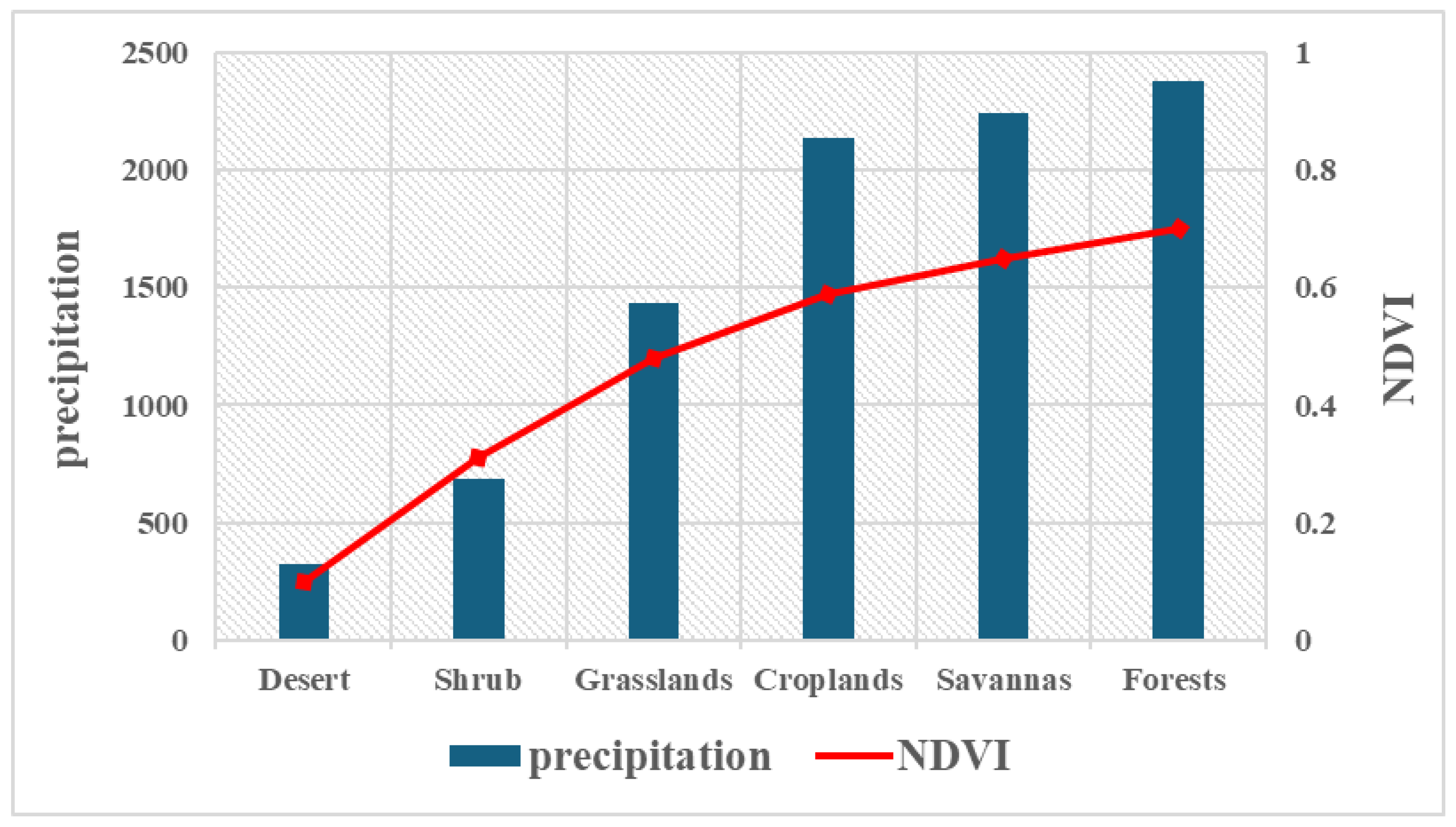
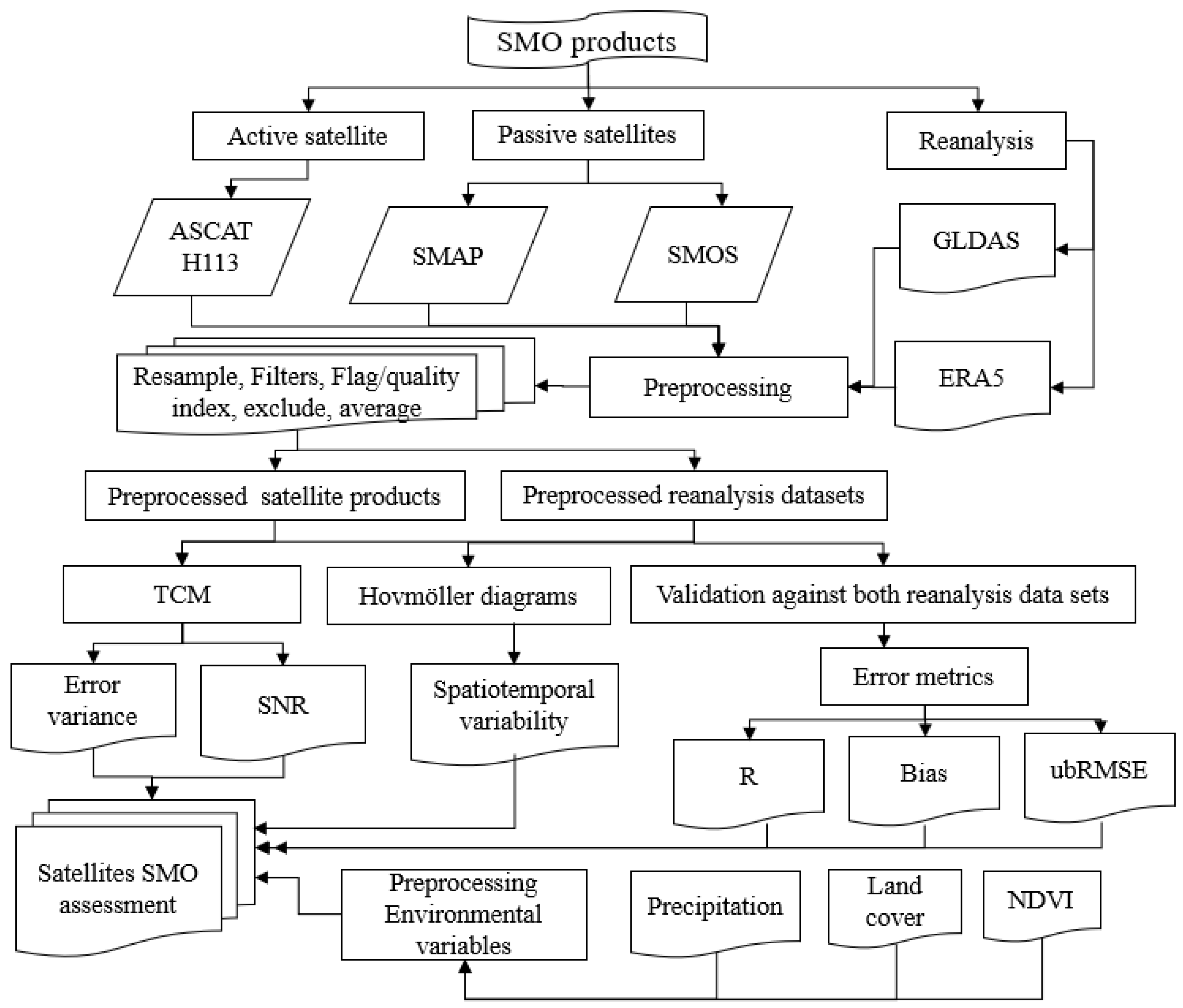
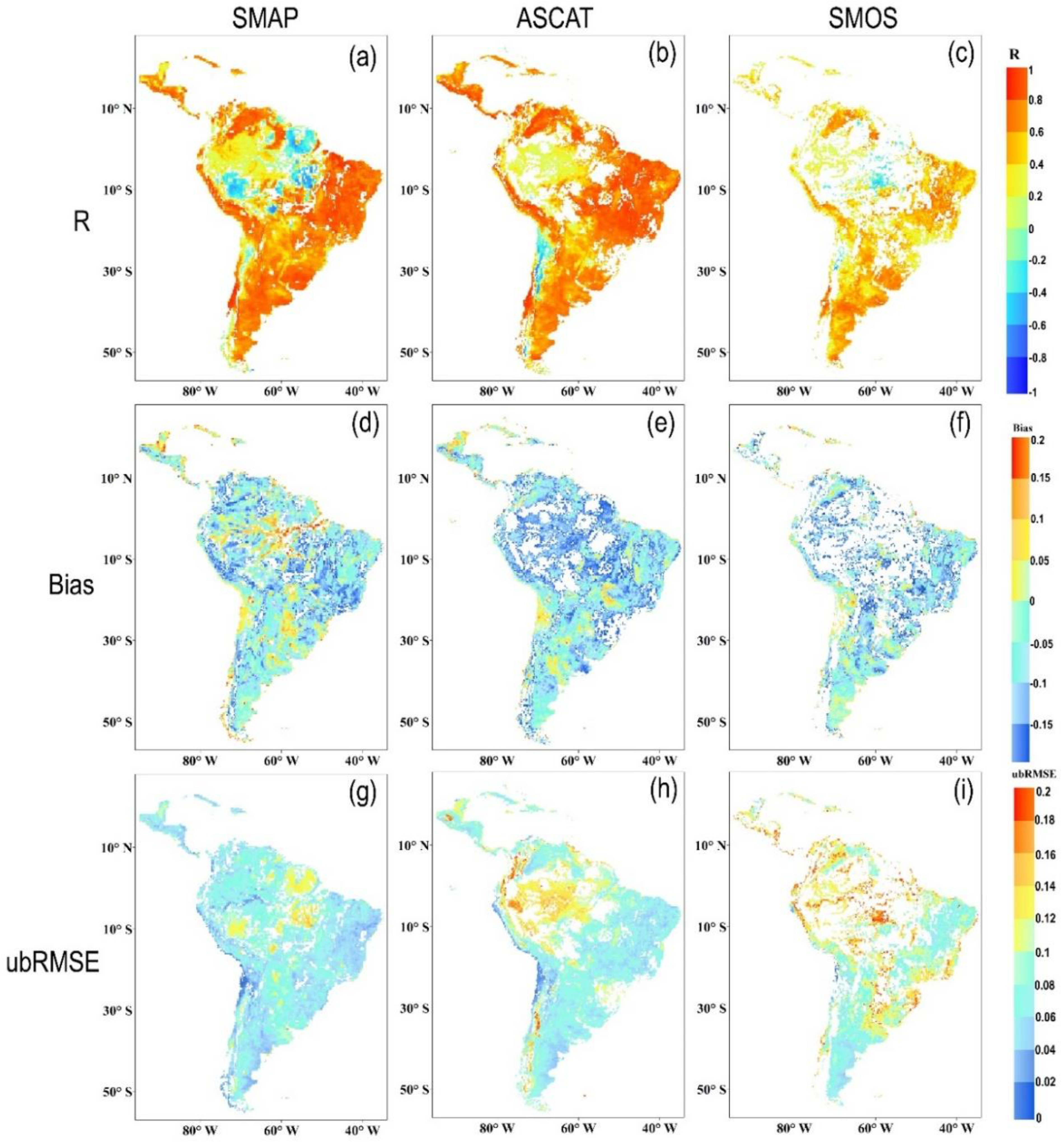
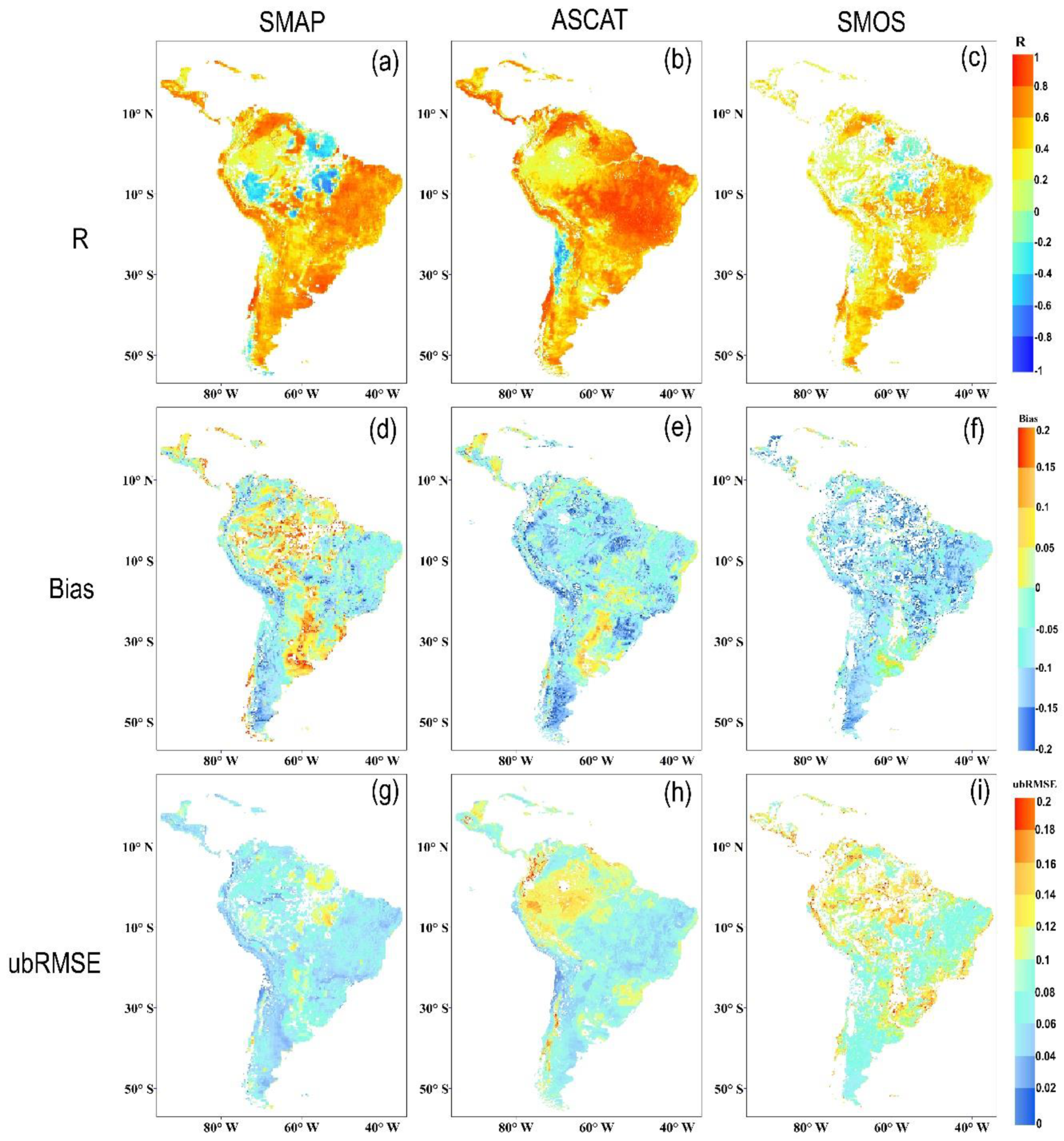
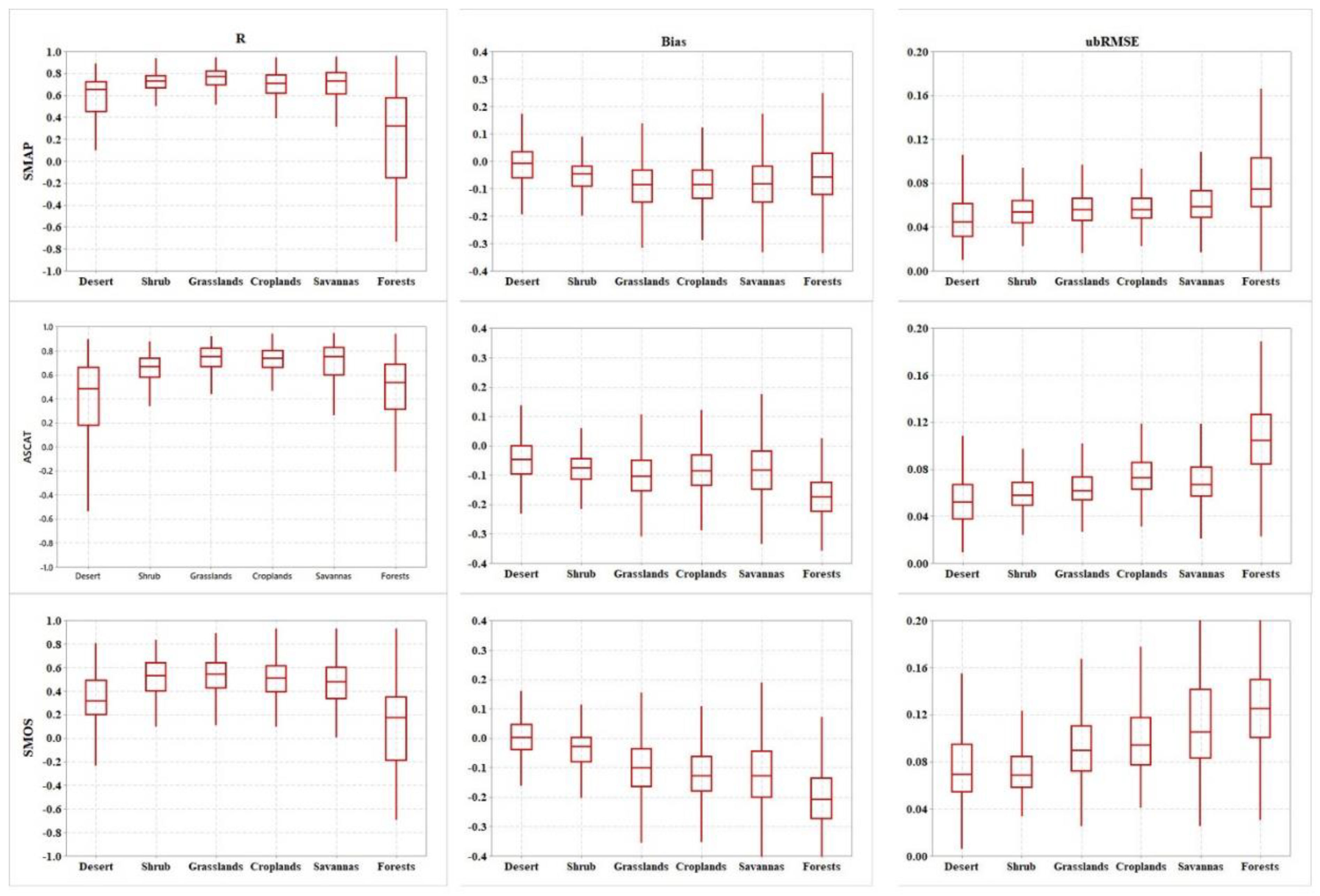
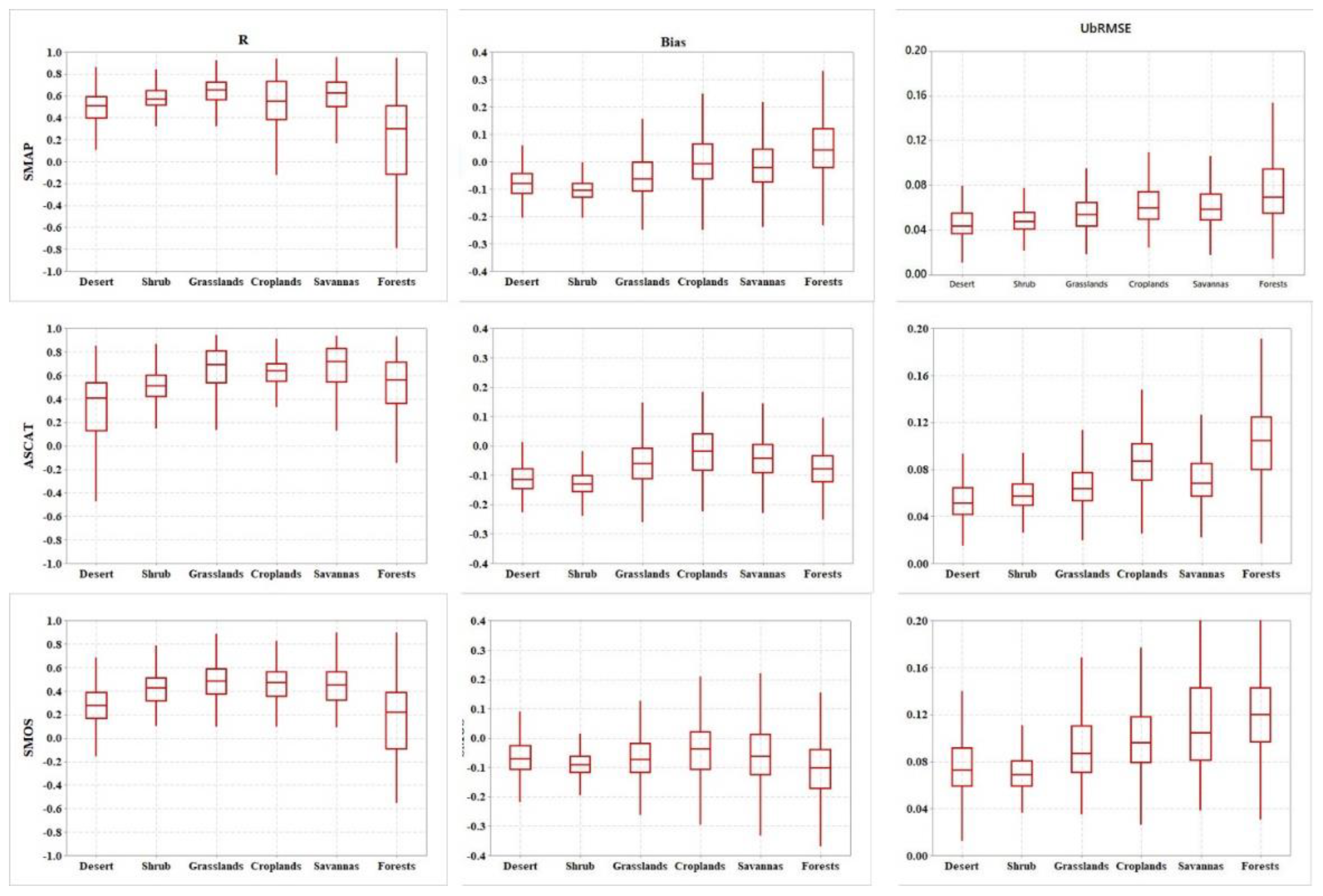
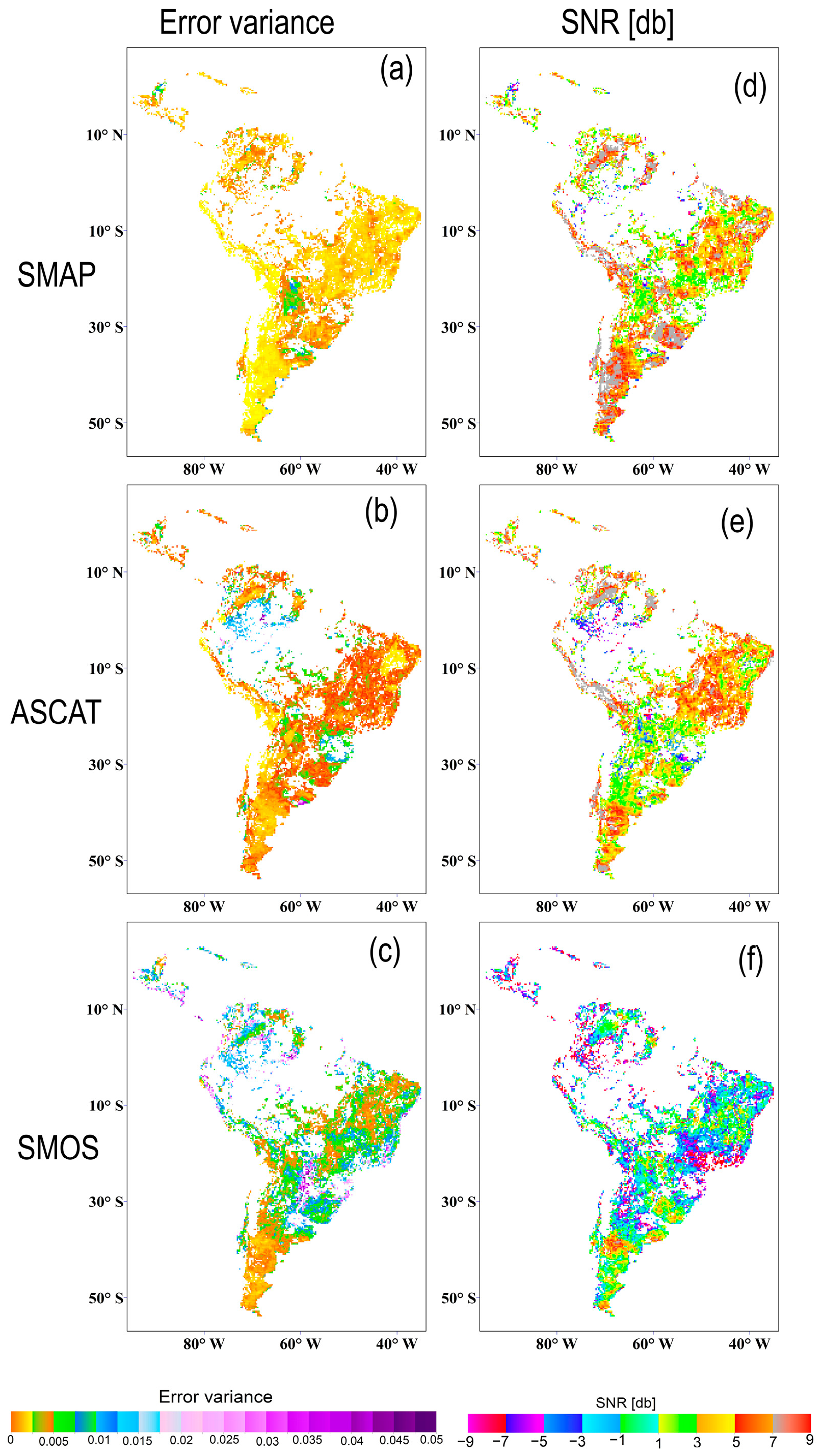
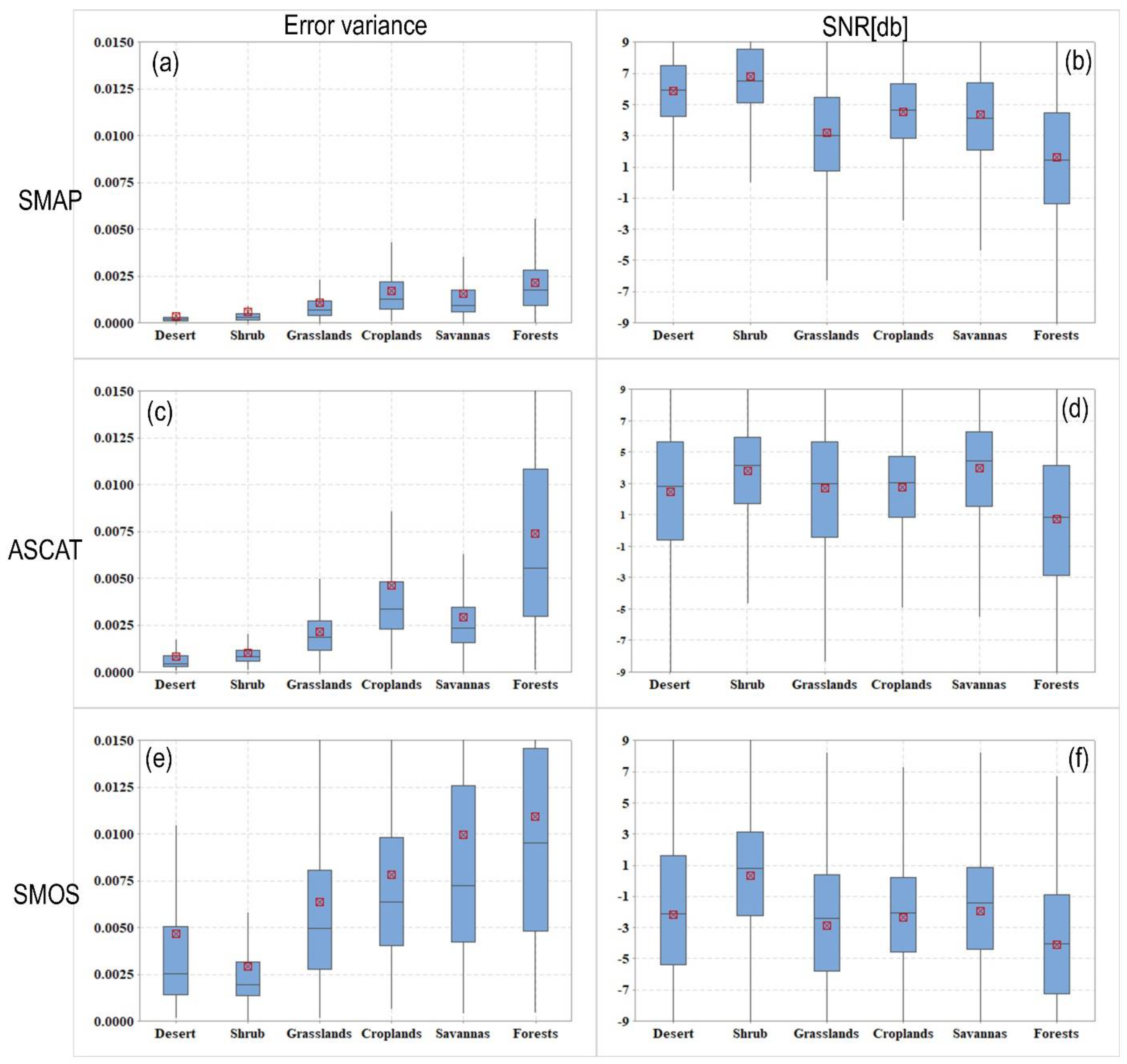
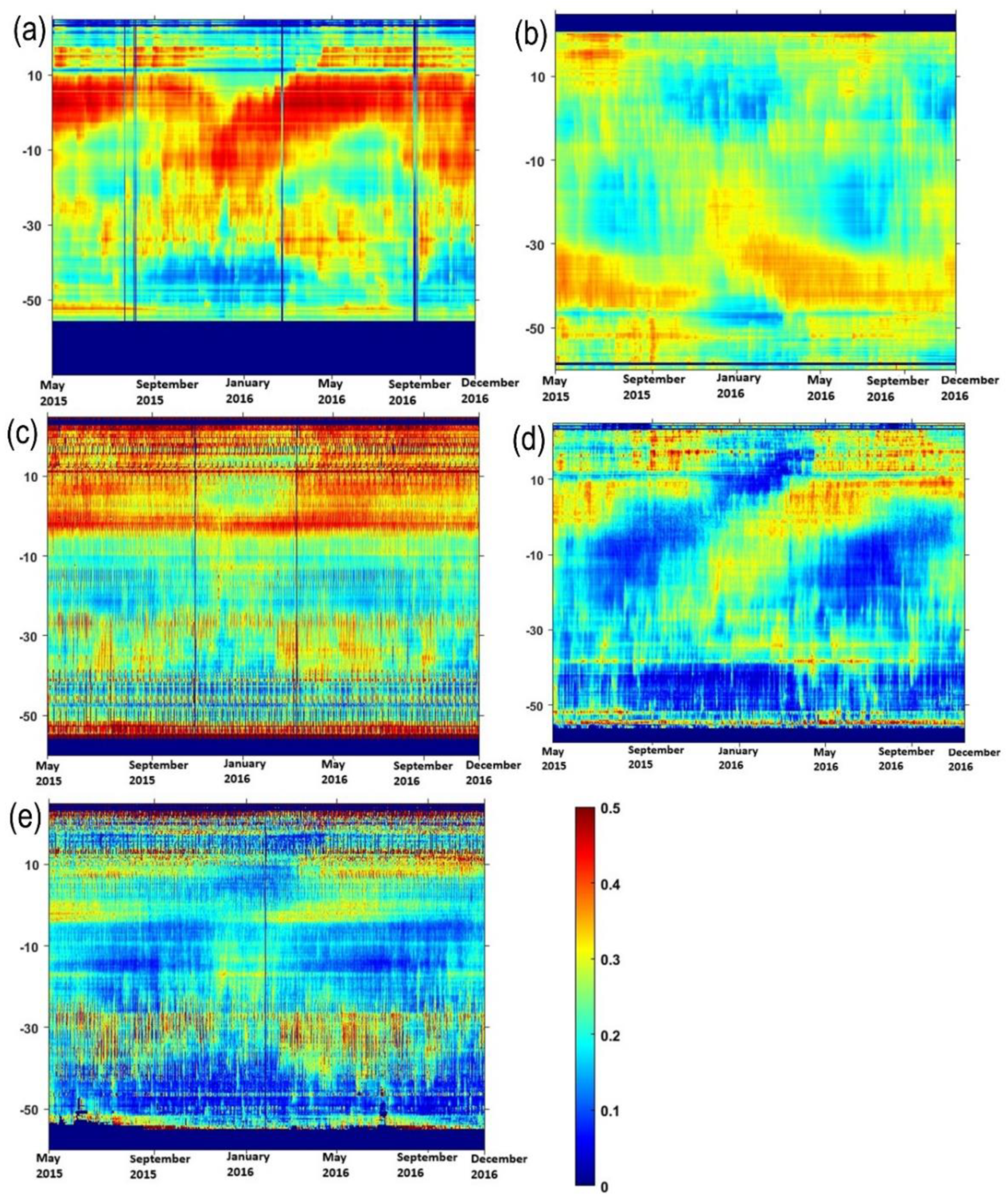
| Overall Average Indexes | R | Bias | ubRMSE | |||
|---|---|---|---|---|---|---|
| ERA5 | GLDAS | ERA5 | GLDAS | ERA5 | GLDAS | |
| SMAP | 0.608 | 0.551 | −0.014 | −0.058 | 0.041 | 0.045 |
| ASCAT | 0.579 | 0.534 | −0.064 | −0.082 | 0.079 | 0.081 |
| SMOS | 0.439 | 0.380 | −0.065 | −0.093 | 0.109 | 0.111 |
Disclaimer/Publisher’s Note: The statements, opinions and data contained in all publications are solely those of the individual author(s) and contributor(s) and not of MDPI and/or the editor(s). MDPI and/or the editor(s) disclaim responsibility for any injury to people or property resulting from any ideas, methods, instructions or products referred to in the content. |
© 2025 by the authors. Licensee MDPI, Basel, Switzerland. This article is an open access article distributed under the terms and conditions of the Creative Commons Attribution (CC BY) license (https://creativecommons.org/licenses/by/4.0/).
Share and Cite
Mousa, B.G.; Samat, A.; Shu, H. Evaluating the Performance of Satellite-Derived Soil Moisture Products Across South America Using Minimal Ground-Truth Assumptions in Spatiotemporal Statistical Analysis. Remote Sens. 2025, 17, 753. https://doi.org/10.3390/rs17050753
Mousa BG, Samat A, Shu H. Evaluating the Performance of Satellite-Derived Soil Moisture Products Across South America Using Minimal Ground-Truth Assumptions in Spatiotemporal Statistical Analysis. Remote Sensing. 2025; 17(5):753. https://doi.org/10.3390/rs17050753
Chicago/Turabian StyleMousa, B. G., Alim Samat, and Hong Shu. 2025. "Evaluating the Performance of Satellite-Derived Soil Moisture Products Across South America Using Minimal Ground-Truth Assumptions in Spatiotemporal Statistical Analysis" Remote Sensing 17, no. 5: 753. https://doi.org/10.3390/rs17050753
APA StyleMousa, B. G., Samat, A., & Shu, H. (2025). Evaluating the Performance of Satellite-Derived Soil Moisture Products Across South America Using Minimal Ground-Truth Assumptions in Spatiotemporal Statistical Analysis. Remote Sensing, 17(5), 753. https://doi.org/10.3390/rs17050753












